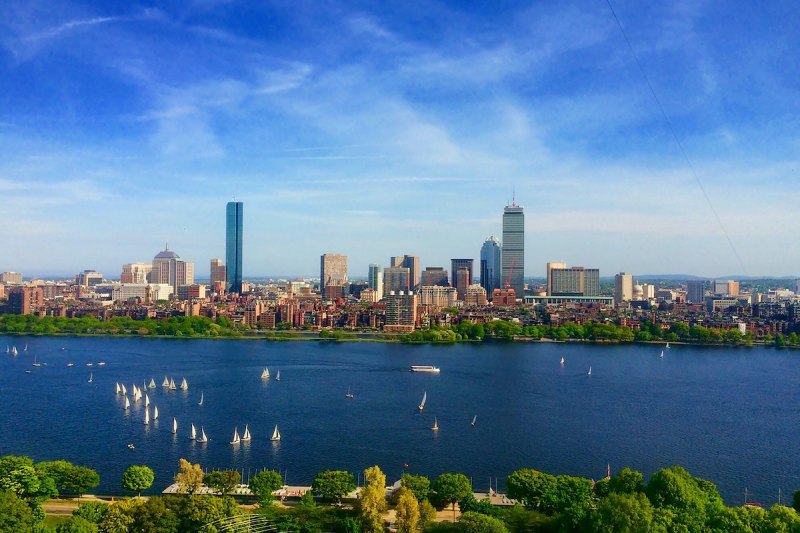
The weather outside this winter wasn’t frightful in many areas accustomed to four seasons. New Yorkers replaced snowy getaways to ski resorts with sunbathing in their neighborhoods — which sometimes felt more like a borderline tropical resort than a quintessential New York winter day. Perhaps you enjoyed the warmer temperatures and the chance to shed your winter coat multiple times during what is supposed to be the coldest time of the year.
If that’s the case, we hate to be a buzz-kill: The warmer winter experienced by people from Kentucky to Massachusetts in the U.S. and multiple locations throughout Europe is a grim sign of climate change. A person trying to fight climate change through investments explained why. However, some spots experienced warm winters — you probably recognize a few and may even live in one.
States that experienced some of the warmest winters on record in 2022-23
The Northeast Regional Climate Center reported that the Northeast had an average temperature of 31.9 degrees Fahrenheit from December through February (the period climatologists and meteorologists consider winter). It’s not precisely Floridian temperatures, but more than 5 degrees warmer than a typical winter. Here’s how it all shook out.
Massachusetts
Federal climate scientists say Massachusetts had its warmest winter on record, tying the 2015-16 mark with an average temperature of 33.7 degrees. That number is nearly 8 degrees higher than the state’s average temperature from 1901-2000.
Kentucky
Kentucky experienced 60- and 70-degree days during the meteorological winter, and its state average of 42.6 degrees is officially the second warmest on record. Lexington’s average temperature was 46.91 degrees in February, 9.3 degrees warmer than usual.
Connecticut
Connecticut’s average temperature in 2022-23 was about 35 degrees, the second highest in history. Sleds stayed in sheds, garages, and closets — aside from a nor’easter, there were few opportunities to make snowmen. Hartford, the capital of Connecticut, experienced its fourth-warmest winter.
New Jersey
New Jersey averaged a whopping 3 inches of snow this winter — 17 inches below the Garden State’s normal. It was the second-lowest total recorded since people started tracking it in 1918-19. The average temperature was 38.5 degrees, 4.5 degrees higher than usual, and tied with 2015-16 for the second-warmest winter. N.J. fell four-tenths of a degree shy of breaking the record set in 2001-02.

Why the record-low temperatures raise flags
Not having to shovel out your car or dress in several layers to walk from your office to the bus stop is nice. However, it’s a sign climate change is real — and something needs to be done.
Why warm weather is a sign of climate change
Scientists phased out the term “global warming” in place of “climate change.” They shared that the term “global warming” gave the impression that only temperature mattered in climate change when other issues, like changing precipitation patterns and sea levels, were even more troubling.
However, that doesn’t mean warm weather isn’t still a sign of climate change.
“Warm winters are a symptom of a larger pattern of global warming,” said Eric Rubenstein, founding partner at New Climate Ventures, a venture capitalist company dedicated to investing in companies that reduce the carbon footprints and effects of climate change. “As Earth’s climate continues to get warmer every year, we’re experiencing more frequent and intense heat waves, droughts, wildfires, and other extreme weather events, as well as warmer winters.”
Why does a warm winter matter?
For the people living in four-season states who wish every day was summer, the winter of 2022-23 may have been a blast. However, Rubenstein believes people should care about the warmer temperatures — it matters, particularly to ecosystems.
“[Warmer winters] can [alter] the timing of seasonal events, such as flowering and bird migrations,” Rubenstein stated. “They can also cause disruptions to agriculture, as crops may not receive the necessary cold temperatures to thrive.”
Changes to crops can affect farmers financially, and the economic impacts don’t stop there.
“In addition to these ecological impacts, warmer winters can also have economic and social impacts,” Rubenstein said. “Ski resorts may struggle to maintain their snow cover, ice fishing, skating, and other winter recreational activities may become less viable.”
What can you do?
Climate change is a complex issue that requires an organized, global systemic effort to fight. Individuals alone can’t solve the problem. However, Rubenstein said that people should still feel empowered to take small steps to reduce their carbon footprints and sustain the world for those who come after them. His ideas include:
- Lower energy consumption by unplugging lights and electronics when they aren’t in use
- Switch to renewable energy if possible and available
- Fix leaks
- Take shorter showers
- Use efficient appliances that lower water usage
- Walk, bike, or ride public transit instead of driving a car alone
- Switch to a fuel-efficient or electric car
- Avoid single-use packaging
- Compost
- Consume more of a plant-based diet, even if it’s one or two meals a week
- Let your wallet do the talking
“Buying carbon neutral or reduced carbon goods when available encourages more low-carbon materials to be made, which supports the flywheel of innovation,” he stated.
The bottom line? Climate change is real, and it can feel not very comforting. Warmer winters are one sign that the planet is getting warmer, and extreme weather events could alter lives and become more common. Systemic change is necessary and falls on the shoulders of global leaders. However, you can still find small ways to make a difference, such as switching to renewable energy, composting, and adhering to Meatless Monday. Support sustainable companies when you can, and speak with your family and friends about your tweaks — it may inspire them and perhaps earn you a snow day in a future winter.
Editors' Recommendations
- How to negotiate a 4 day workweek and improve your work-life balance today
- These are the pitfalls of a 4-day workweek you haven’t thought about
- Watch how one MLB rule change led to a 20-second at-bat, strikeout
- Beyond the booze: A historian explains the real history of St. Patrick’s Day
- The U.S. government has a real inflation calculator anyone can use




